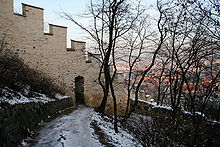Hunger Wall
This article includes a improve this article by introducing more precise citations. (January 2022) |


The Hunger Wall (
Marl from quarries on Petřín Hill was used as construction material. The purpose of the construction was to strengthen the fortifications of Prague Castle and Malá Strana against any attack from the west or south. Originally the wall was 4 to 4.5 metres high and 1.8 metres wide and was equipped with battlements and (probably) eight bastions.
The wall was repaired in 1624, further strengthened in the middle of 18th century and repaired or modified several times later (in modern era in 1923-25 and 1975). One of preserved bastions serves as a base for the dome of
A well preserved part of the wall may also be found in the interior yard of the 19th-century house in Plaská Street No.8.
The name and associated myths
The wall was originally called Zubatá (toothed) or Chlebová (built for bread). The adjective Hladová (hungry) appeared after a 1361
Sources
- Julius Košnář: Staropražské pověsti a legendy (= Myths and legends from old Prague). Vincentinum, Praha 1933, Chapter: O Hladové zdi, p. 268 (Czech, available online).
- Hladová zeď on turistika.cz (in Czech)
- Hladová zeď on praguecityline.cz (in Czech)50°04′59″N 14°23′42″E / 50.083°N 14.395°E
